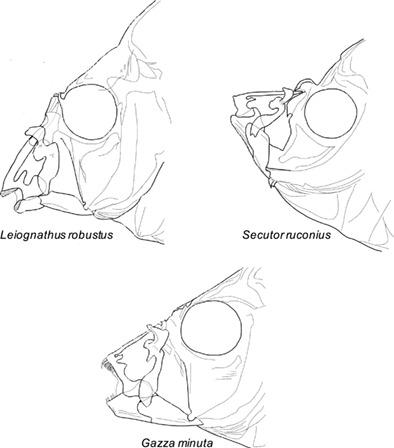当前位置:
X-MOL 学术
›
J. Morphol.
›
论文详情
Our official English website, www.x-mol.net, welcomes your
feedback! (Note: you will need to create a separate account there.)
Anatomical basis of diverse jaw protrusion directionality in ponyfishes (Family Leiognathidae)
Journal of Morphology ( IF 1.5 ) Pub Date : 2021-01-13 , DOI: 10.1002/jmor.21314 Alexus S Roberts 1 , Jennifer R Hodge 2 , Prosanta Chakrabarty 3 , Peter C Wainwright 1
Journal of Morphology ( IF 1.5 ) Pub Date : 2021-01-13 , DOI: 10.1002/jmor.21314 Alexus S Roberts 1 , Jennifer R Hodge 2 , Prosanta Chakrabarty 3 , Peter C Wainwright 1
Affiliation

|
Protrusion of the oral jaws is a key morphological innovation that enhances feeding performance in fishes. The mechanisms of protrusion and the basis of variation in its magnitude are well studied, but little attention has been paid to the functional morphology of protrusion directionality, despite wide variation among teleost species from slightly dorsal to strongly ventral. Ponyfishes (Leiognathidae) comprise a group of 52 species that exhibit striking diversity in the directionality of jaw protrusion, providing a promising system for exploring its underlying basis in a single clade. We examined the anatomical basis of protrusion directionality by measuring eight traits associated with the size and positioning of oral jaw bones. Measurements were made on cleared and stained specimens of 20 ponyfish species, representing every major lineage within the family. Species fell into three non-overlapping clusters with respect to directionality including dorsal, rostral, and ventral protruders. A key correlate of protrusion direction is the anterior-posterior position of the articular-quadrate jaw joint. As the joint position moves from a posterior to a more anterior location, the orientation of the relaxed mandible rotates from an almost horizontal resting position to an upright vertical posture. Abduction of the mandible from the horizontal position results in ventrally directed protrusion, while the more upright mandible rotates to a position that maintains dorsal orientation. The resting orientation of the premaxilla and maxilla, thus, vary consistently with protrusion direction. Mouth size, represented by length of the mandible and maxilla, is a second major axis of variation in ponyfishes that is independent of variation in protrusion directionality.
中文翻译:

小马鱼不同颌前突方向的解剖学基础(鲽科)
口腔颌骨的突出是提高鱼类摄食性能的关键形态创新。突出的机制及其幅度变化的基础得到了很好的研究,但很少有人关注突出方向性的功能形态,尽管硬骨鱼物种从轻微的背侧到强烈的腹侧变化很大。小马鱼 (Leiognathidae) 包括一组 52 种,它们在下颌突出的方向性方面表现出惊人的多样性,为在单个进化枝中探索其潜在基础提供了一个有前途的系统。我们通过测量与口腔颌骨的大小和位置相关的八个特征来检查前突方向的解剖学基础。对 20 种马鱼的清除和染色标本进行了测量,代表家族中的每一个主要血统。物种在方向性方面分为三个不重叠的集群,包括背侧、嘴侧和腹侧突起。突出方向的一个关键相关因素是关节-方形颌关节的前后位置。随着关节位置从后面移动到更前面的位置,放松的下颌骨的方向从几乎水平的静止位置旋转到直立的垂直姿势。下颌骨从水平位置外展导致向腹侧突出,而更直立的下颌骨旋转到保持背侧方向的位置。因此,前上颌骨和上颌骨的静止方向随突出方向而变化。嘴的大小,由下颌骨和上颌骨的长度表示,
更新日期:2021-01-13
中文翻译:

小马鱼不同颌前突方向的解剖学基础(鲽科)
口腔颌骨的突出是提高鱼类摄食性能的关键形态创新。突出的机制及其幅度变化的基础得到了很好的研究,但很少有人关注突出方向性的功能形态,尽管硬骨鱼物种从轻微的背侧到强烈的腹侧变化很大。小马鱼 (Leiognathidae) 包括一组 52 种,它们在下颌突出的方向性方面表现出惊人的多样性,为在单个进化枝中探索其潜在基础提供了一个有前途的系统。我们通过测量与口腔颌骨的大小和位置相关的八个特征来检查前突方向的解剖学基础。对 20 种马鱼的清除和染色标本进行了测量,代表家族中的每一个主要血统。物种在方向性方面分为三个不重叠的集群,包括背侧、嘴侧和腹侧突起。突出方向的一个关键相关因素是关节-方形颌关节的前后位置。随着关节位置从后面移动到更前面的位置,放松的下颌骨的方向从几乎水平的静止位置旋转到直立的垂直姿势。下颌骨从水平位置外展导致向腹侧突出,而更直立的下颌骨旋转到保持背侧方向的位置。因此,前上颌骨和上颌骨的静止方向随突出方向而变化。嘴的大小,由下颌骨和上颌骨的长度表示,









































 京公网安备 11010802027423号
京公网安备 11010802027423号